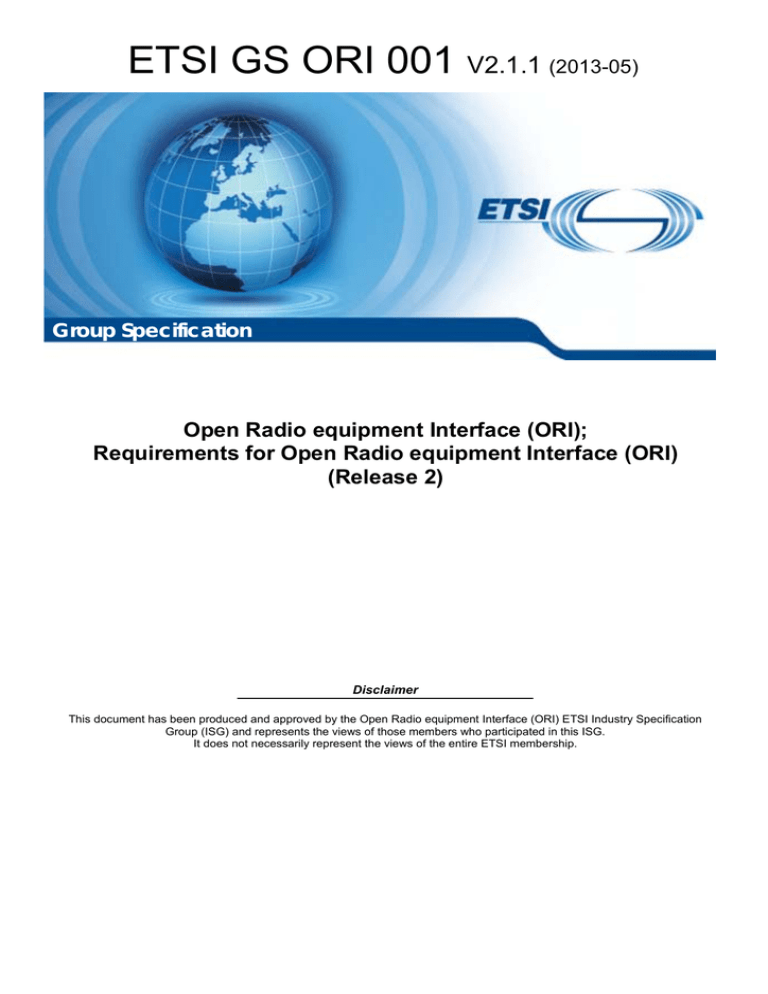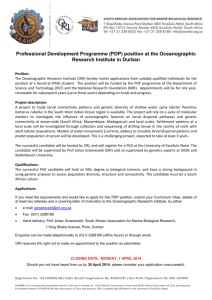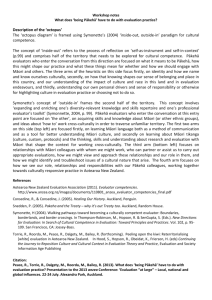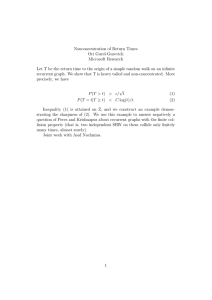ETSI GS ORI 001 V2.1.1
advertisement

ETSI GS ORI 001 V2.1.1 (2013-05) Group Specification Open Radio equipment Interface (ORI); Requirements for Open Radio equipment Interface (ORI) (Release 2) Disclaimer This document has been produced and approved by the Open Radio equipment Interface (ORI) ETSI Industry Specification Group (ISG) and represents the views of those members who participated in this ISG. It does not necessarily represent the views of the entire ETSI membership. 2 ETSI GS ORI 001 V2.1.1 (2013-05) Reference RGS/ORI-0006 Keywords E-UTRA, interface, radio, UTRA ETSI 650 Route des Lucioles F-06921 Sophia Antipolis Cedex - FRANCE Tel.: +33 4 92 94 42 00 Fax: +33 4 93 65 47 16 Siret N° 348 623 562 00017 - NAF 742 C Association à but non lucratif enregistrée à la Sous-Préfecture de Grasse (06) N° 7803/88 Important notice Individual copies of the present document can be downloaded from: http://www.etsi.org The present document may be made available in more than one electronic version or in print. In any case of existing or perceived difference in contents between such versions, the reference version is the Portable Document Format (PDF). In case of dispute, the reference shall be the printing on ETSI printers of the PDF version kept on a specific network drive within ETSI Secretariat. Users of the present document should be aware that the document may be subject to revision or change of status. Information on the current status of this and other ETSI documents is available at http://portal.etsi.org/tb/status/status.asp If you find errors in the present document, please send your comment to one of the following services: http://portal.etsi.org/chaircor/ETSI_support.asp Copyright Notification No part may be reproduced except as authorized by written permission. The copyright and the foregoing restriction extend to reproduction in all media. © European Telecommunications Standards Institute 2013. All rights reserved. TM TM TM DECT , PLUGTESTS , UMTS and the ETSI logo are Trade Marks of ETSI registered for the benefit of its Members. TM 3GPP and LTE™ are Trade Marks of ETSI registered for the benefit of its Members and of the 3GPP Organizational Partners. GSM® and the GSM logo are Trade Marks registered and owned by the GSM Association. ETSI 3 ETSI GS ORI 001 V2.1.1 (2013-05) Contents Intellectual Property Rights ................................................................................................................................4 Foreword.............................................................................................................................................................4 Introduction ........................................................................................................................................................4 1 Scope ........................................................................................................................................................5 2 References ................................................................................................................................................5 2.1 2.2 2.3 3 3.1 3.2 4 4.1 4.1.1 4.1.2 4.2 4.2.1 4.2.2 4.3 4.3.1 4.3.1.1 4.3.1.2 4.3.2 4.3.2.1 4.3.2.2 4.3.3 4.3.3.1 4.3.3.2 4.4 4.4.1 4.5 4.5.1 4.6 4.6.1 Normative references ......................................................................................................................................... 5 Informative references ........................................................................................................................................ 6 Document structure of the ORI specifications.................................................................................................... 6 Definitions and abbreviations ...................................................................................................................6 Definitions .......................................................................................................................................................... 6 Abbreviations ..................................................................................................................................................... 7 ORI system requirements .........................................................................................................................8 Reference configurations .................................................................................................................................... 8 Topology ....................................................................................................................................................... 8 Specific ORI node requirements on ORI links and ORI ports .................................................................... 10 Supported radio standards ................................................................................................................................ 11 System requirements ................................................................................................................................... 11 Specific ORI node requirements ................................................................................................................. 11 Protocol Requirements ..................................................................................................................................... 11 Compliance with CPRI ............................................................................................................................... 11 System requirements ............................................................................................................................. 11 Specific ORI node requirements ........................................................................................................... 12 C&M functionality...................................................................................................................................... 12 System requirements ............................................................................................................................. 12 Specific ORI node requirements ........................................................................................................... 13 C&M signalling and transport .................................................................................................................... 13 System requirements ............................................................................................................................. 13 Specific ORI node requirements ........................................................................................................... 13 Redundancy ...................................................................................................................................................... 13 General........................................................................................................................................................ 13 Interoperability ................................................................................................................................................. 13 General........................................................................................................................................................ 13 Forwards compatibility..................................................................................................................................... 13 General........................................................................................................................................................ 13 History ..............................................................................................................................................................14 ETSI 4 ETSI GS ORI 001 V2.1.1 (2013-05) Intellectual Property Rights IPRs essential or potentially essential to the present document may have been declared to ETSI. The information pertaining to these essential IPRs, if any, is publicly available for ETSI members and non-members, and can be found in ETSI SR 000 314: "Intellectual Property Rights (IPRs); Essential, or potentially Essential, IPRs notified to ETSI in respect of ETSI standards", which is available from the ETSI Secretariat. Latest updates are available on the ETSI Web server (http://ipr.etsi.org). Pursuant to the ETSI IPR Policy, no investigation, including IPR searches, has been carried out by ETSI. No guarantee can be given as to the existence of other IPRs not referenced in ETSI SR 000 314 (or the updates on the ETSI Web server) which are, or may be, or may become, essential to the present document. Foreword This Group Specification (GS) has been produced by ETSI Industry Specification (ISG) Open Radio equipment Interface (ORI). The contents of the present document are subject to continuing work within the ISG. Should the ISG modify the contents of the present document, it will be re-released by the ISG with an identifying change of release date and an increase in version number as follows: Version x.y.z where: x the first digit indicates the release number of ORI specification group starting from Release 1. y the second digit is incremented for all changes of substance, i.e. technical enhancements, corrections, updates, etc. z the third digit is incremented when editorial only changes have been incorporated in the document. Introduction Mobile communication networks have evolved from 1st generation to 3rd, and now, many operators are preparing to introduce LTE. Economical and efficient deployment of base stations is one of key issues for the success of mobile services. Operators also consider ecological aspects when renewing a system. In general mobile radio base stations consist of a BaseBand Unit (BBU) and a Radio Frequency Unit (RFU), which usually is a Remote Radio Head (RRH) in a distributed base station architecture. Current interfaces between BBU and RRH are provided in a "semi proprietary" nature, although based on industry standards like CPRI or OBSAI. In order to gain flexibility operators are looking for distributed base station architectures with separate BBUs and RRHs. In order to gain interoperability, BBU and RRH are interconnected via an open BBU-RRH Interface (ORI) for flexible combination from different vendors. ORI is about a digitized radio base station interface that establishes a connection between "Radio Equipment Control" (REC) and "Radio Equipment" (RE) enabling single-hop and multi-hop topologies. Different information flows (User Plane data, Control and Management Plane data, and Synchronization Plane data) are multiplexed over the interface. ORI covers OSI protocol layer 1, Layer 2 up to Layer 7. The present document aims to define a set of system and link requirements that apply to the Open Radio equipment Interface (ORI). ETSI 5 1 ETSI GS ORI 001 V2.1.1 (2013-05) Scope ETSI Group Specifications (GS) are deliverables produced by Industry Specification Groups (ISG). GSs are written with the style of a Technical Specification (TS), and represent the sole view of the ISG members. The present document describes system-level requirements that apply to the Open Radio equipment Interface (ORI) and ORI nodes for Release 2. NOTE: 2 Requirements comply with CPRI specification of CPRI forum [1] and focuses on the following 3GPP radio access technologies namely UTRA-FDD [3], [4] and [5], E-UTRA-FDD [6] and E-UTRA-TDD [6]. Multiplexing between UTRA-FDD and E-UTRA-FDD is also considered. References References are either specific (identified by date of publication and/or edition number or version number) or non-specific. For specific references, only the cited version applies. For non-specific references, the latest version of the reference document (including any amendments) applies. Referenced documents which are not found to be publicly available in the expected location might be found at http://docbox.etsi.org/Reference. NOTE: 2.1 While any hyperlinks included in this clause were valid at the time of publication ETSI cannot guarantee their long term validity. Normative references The following referenced documents are necessary for the application of the present document. [1] NOTE: "Common Public Radio Interface (CPRI); Interface Specification" V 4.2. Available at http://www.cpri.info/spec.html. [2] ETSI GS ORI 002-1: "Open Radio equipment Interface (ORI); ORI Interface Specification; Part 1: Low Layers (Release 2)". [3] ETSI TS 125 104: "Universal Mobile Telecommunications System (UMTS); Base Station (BS) radio transmission and reception (FDD) (3GPP TS 25.104)". [4] ETSI TS 125 215: "Universal Mobile Telecommunications System (UMTS); Physical layer; Measurements (FDD) (3GPP TS 25.215)". [5] ETSI TS 125 133: "Universal Mobile Telecommunications System (UMTS); Requirements for support of radio resource management (FDD) (3GPP TS 25.133)". [6] ETSI TS 136 104: "LTE; Evolved Universal Terrestrial Radio Access (E-UTRA); Base Station (BS) radio transmission and reception (3GPP TS 36.104)". [7] ETSI GS ORI 002-2: "Open Radio equipment Interface (ORI); ORI Interface Specification; Part 2: Control and Management (Release 2)". [8] ETSI TS 125 461 (V10.2.0): "Universal Mobile Telecommunications System (UMTS); UTRAN Iuant interface: Layer 1 (3GPP TS 25.461)". [9] ETSI TS 125 462 (V10.1.0): "Universal Mobile Telecommunications System (UMTS); UTRAN Iuant interface: Signalling transport (3GPP TS 25.462)". [10] ETSI TS 125 466 (V10.3.0): "Universal Mobile Telecommunications System (UMTS); UTRAN Iuant interface: Application part (3GPP TS 25.466)". ETSI 6 [11] 2.2 ETSI GS ORI 001 V2.1.1 (2013-05) Antenna Interface Standards Group, Standard No. AISG v2.0, 13th June 2006: "Control interface for antenna line devices". Informative references The following referenced documents are not necessary for the application of the present document but they assist the user with regard to a particular subject area. Not applicable. 2.3 Document structure of the ORI specifications Figure 2.3.1: Document structure of the ORI specifications NOTE: The Low Layers specification [2] covers a single ORI link. The C&M specification [7] covers C&M communication between one REC and one RE. The present requirements specification covers a system configuration of multiple ORI links between one REC and one or multiple REs and optionally additional subsequent ORI links between those REs and other REs. 3 Definitions and abbreviations 3.1 Definitions For the purposes of the present document, the following terms and definitions apply: active link: ORI link that supports at least one C&M signalling channel antenna line device: See [11]. downlink: direction from REC to RE for a logical connection hop: aggregation of all ORI links directly connecting two ORI nodes ETSI 7 ETSI GS ORI 001 V2.1.1 (2013-05) logical connection: interconnection between a particular SAP belonging to a port of the REC and the corresponding peer SAP belonging to a port of one particular RE and builds upon a single hop, or a multi-hop connection, between the REC and that particular RE NOTE: Logical connections for C&M data, user plane data and synchronization can be distinguished. master port and slave port: See section 2.1 in [1]. multi-hop connection: set of continuously connected hops starting from the REC and ending at a particular RE including REs in between networking RE: RE with at least one ORI Port in master role ORI link: bidirectional interface in between two directly-connected ORI ports, on two ORI nodes NOTE: A working link consists of a master port and a slave port. ORI node: subsystems REC and RE are also called ORI nodes, when either an REC or an RE is meant ORI port: master port or slave port on an REC or an RE passive link: ORI link that does not support any C&M channel protocol data planes: the following data flows are discerned: • Control and Management (C&M) Plane: Control data flow used for call processing while the management data flow is for the operation, administration and maintenance of the ORI link and the nodes. The control plane and management plane are mapped to a Service Access Point SAP. • User Plane: Data that has to be transferred from the radio base station to the mobile station and vice versa. These data are transferred in the form of IQ data. Several IQ data flows are sent via one physical ORI link. Each IQ data flow reflects the data of one antenna for one carrier. • Synchronization: Data flow which transfers synchronization and timing information between nodes. Service Access Points (SAP): See section 2.1 in [1]. subsystems: radio base station system is composed of two basic subsystems, the radio equipment control and the radio equipment uplink: direction from RE to REC for a logical connection NOTE: 3.2 For any terms used in the present document that are not defined either here or directly in the section in which they are used, refer to [1]. Abbreviations For the purposes of the present document, the following abbreviations apply: 3GPP AISG BBU C&M CPRI E-UTRA FDD IQ O&M OBSAI ORI OSI RE REC RFU 3rd Generation Partnership Project Antenna Interface Standards Group BaseBand Unit Control and Management Common Public Radio Interface Evolved UMTS Terrestrial Radio Access Frequency Division Duplex In-phase data and Quadrature data Operation and Maintenance Open Base Station Architecture Initiative Open Radio equipment Interface Open Systems Interconnection Radio Equipment Radio Equipment Control Radio Frequency Unit ETSI 8 RRH SAP TDD UTRA ETSI GS ORI 001 V2.1.1 (2013-05) Remote Radio Head Service Access Point Time Division Duplex UMTS Terrestrial Radio Access 4 ORI system requirements 4.1 Reference configurations 4.1.1 Topology The following networking topologies shall be supported by the present release of the ORI interface: For single-REC single hop: • Single point-to-point link between one REC and one RE (figure 4.1.1). • Multiple point-to-point links between one REC and one RE (figure 4.1.2). • Multiple point-to-point links between one REC and several REs (Star topology) (figure 4.1.3). For single-REC multi-hop: • Chain (figure 4.1.4). • Tree (figure 4.1.5). • Ring (figure 4.1.6). For single-REC multi-hop topologies, the specification shall be designed to support the following: • both the "simple solution" and "general solution" for networking, as described in section 6.3 of [1], including: - the capability for the line bit rate used on ORI links to be different across different hops; - the capability for data to be transported via AxCs mapped to M slave ports to be able to be switched by the networking RE to/from N master ports, where M≠N. The capability for the REC to configure an RE that is connected to the REC via a networking RE without affecting radio interface transmission on the networking RE, and vice versa. Figure 4.1.1: Single point-to-point link between one REC and one RE Figure 4.1.2: Multiple point-to-point links between one REC and one RE ETSI 9 ETSI GS ORI 001 V2.1.1 (2013-05) RE ) (s k in L I R O REC O R I L in k( s ) RE Figure 4.1.3: Multiple point-to-point links between one REC and several REs (star topology) Figure 4.1.4: Chain topology O R O IR L Ii n L k in k Figure 4.1.5: Tree topology Figure 4.1.6: Ring topology ETSI 10 4.1.2 ETSI GS ORI 001 V2.1.1 (2013-05) Specific ORI node requirements on ORI links and ORI ports In support of the topology options as specified for the present release of ORI, the following is required of the RE and REC: • A hop shall support at least one active link. As per the single-hop topologies defined in clause 4.1.1 it is assumed REC ports are only master ports and RE ports are only slave ports. As per the single-REC multi-hop topologies defined in clause 4.1.1, it is assumed that REC ports are only master ports and each RE port may take a master port role or a slave port role within the constraints defined below. The REC shall manage which ORI ports act as a master port in the RE (within the RE’s ORI port role capabilities). The following requirements shall then apply: • The RE without the capability to be a networking RE shall support 1 to 255 ORI ports. • The RE with the capability to be a networking RE shall support 2 to 255 ORI ports, and shall support the simultaneous configuration of at least one ORI port as a master port and at least one other ORI port as a slave port. • The REC shall support 1 to 255 ORI ports. All ORI Links terminated by an ORI port in slave role at the RE shall have their timing generated by the same timing source. NOTE: Further restrictions may be needed for multi-REC topologies in the future. In order to support single-REC multi-hop topologies, the RE acting as a networking RE is expected to support the following: • At least the simplified solution for networking, described in section 6.3 of [1]. • The forwarding of all the SAPs defined in [1] through the unit between relevant master and slave ports, The networking RE shall not forward SAPs defined in [1] from one slave port to another slave port, e.g. in ring topology. • The forwarding of the contents of the control words defined within the "ORI reserved field", the "vendor-specific area" between the relevant master and slave ports. Given that the RE is only required to terminate one active link at any one time, in the ring topology a break in the ring affecting the routeing of the active link would cause one or more REs to require C&M re-establishment. See figure 4.1.7. ETSI 11 Master ETSI GS ORI 001 V2.1.1 (2013-05) Master REC Active Active Slave RE3 Slave Link break (rerouting of Active Link via RE2 required RE1 Slave Master Passive Active RE2 Master Slave Figure 4.1.7: Example of need for C&M re-establishment following link break in ring topology 4.2 Supported radio standards 4.2.1 System requirements The following technologies shall be supported by the present release of the ORI interface: • UTRA-FDD [3], [4] and [5]; • E-UTRA-FDD [6]; • E-UTRA-TDD [6]. 3GPP releases and versions relevant to the above radio standards are specified in [1], section 3.1. Multiplexing between UTRA-FDD and E-UTRA-FDD on a link shall also be supported. 4.2.2 Specific ORI node requirements In support of the technology options as specified for the present release of ORI, the following is required of the RE and REC: • The RE/REC shall support at least one of UTRA-FDD, E-UTRA-FDD, or E-UTRA-TDD, and may optionally support multiplexing between UTRA-FDD and E-UTRA-FDD. 4.3 Protocol Requirements 4.3.1 Compliance with CPRI 4.3.1.1 System requirements The CPRI specification as specified in [1] shall be the baseline for the ORI Low Layers specification [2]. In line with that, the ORI shall be compliant with all of the requirements in [1] for the applicable topologies and radio standards as specified for the present release of ORI. Furthermore, in order to make the ORI specification fully inter-operable, it may be necessary to restrict the number of options defined in [1] for usage within ORI. Such restrictions shall be described in the ORI specifications. ETSI 12 4.3.1.2 ETSI GS ORI 001 V2.1.1 (2013-05) Specific ORI node requirements The RE/REC compliant to the ORI specifications shall: • be fully compliant to CPRI, as defined in section 5.2 of [1]; • support mandatory requirements defined within ORI that are defined as options within CPRI; • support mandatory requirements defined within ORI on all layers (specified in the present document, as well as [2] and [7]) that do not refer to functionality in CPRI specifications. 4.3.2 C&M functionality 4.3.2.1 System requirements The following aspects shall be supported by the interface: • C&M plane protocol stack. • RE Resource Management. • RE Fault management: Full fault concept and states as well as the stable fault types. • C&M protocol encoding and rules. The following C&M procedures shall be supported by the interface: • Device Management: - • Software Management: - • Fault Management shall be the procedures required to report fault conditions within the RE and transfer of additional information about events that have occurred within the RE (log files). Performance Management: - • Resource State Management shall be the procedures required to change the operating mode of the RE resources and report the current operating state. Fault Management: - • Configuration Management shall be the procedures enable the REC to configure the RE to perform cell transmission and reception over the radio interface, via data provided over the ORI link. Resource State Management: - • Software Management shall be the procedures required to determine the version of software currently available on the RE and the procedure to update and activate the software on the RE. Configuration Management: - • Device Management shall be the procedures required to manage the RE as a device, including: Establishment of a C&M layer, Maintaining communication, Reset of the device and Setting the Time of Day in the RE. Performance Management shall be the procedures required determine the operating performance of the RE. AISG support: - Support the communication towards Antenna Line Devices which have a physical connection to the RE, in line with the 3GPP Iuant interface defined in [8], [9], [10] and AISG specification [11]. ETSI 13 4.3.2.2 ETSI GS ORI 001 V2.1.1 (2013-05) Specific ORI node requirements See clause 4.3.1.2. 4.3.3 4.3.3.1 C&M signalling and transport System requirements Any necessary additions to [1] shall be made in the ORI specification to provide transport for any C&M signalling required to fulfil the C&M functionality requirements. CPRI defined "Fast C&M signalling channel based on Ethernet" shall be supported by the present release of the ORI interface. 4.3.3.2 Specific ORI node requirements Requirements on RE/REC for signalling transport are defined in [2]. 4.4 Redundancy 4.4.1 General Optimizations to redundancy-switching is deferred to future releases. 4.5 Interoperability 4.5.1 General The interface shall enable interoperability between products of different vendors. Any restrictions to the requirements in [1] or any other existing protocols used by ORI to enable interoperability shall be described in the ORI specifications. Any knowledge of ORI support in the RE (and any subsequent RE connected to the RE connected directly to the REC) prior to C&M link establishment needs to be provisioned in the REC via O&M. NOTE: The concurrent operation of compliant and non-compliant ORI nodes is not specified in the ORI specifications. 4.6 Forwards compatibility 4.6.1 General The release 1 of the ORI specification targets basic deployment and related interoperability. The release 2 of the ORI specification adds the support of chain, tree, and ring topologies as well as an additional line rate. The release 2 of the ORI specification shall also attempt to enable hardware-compatibility towards future Releases of the ORI specification, for such functionality where extensions are foreseen as needed. Foreseen future topologies include multi-REC topologies. Foreseen future functionalities include optimizations to redundancy-switching, especially considering optimizations for switching between two active links terminated by slave ports on the same RE. ETSI 14 History Document history V1.1.1 October 2011 Publication V1.2.1 August 2012 Publication V2.1.1 May 2013 Publication ETSI ETSI GS ORI 001 V2.1.1 (2013-05)


